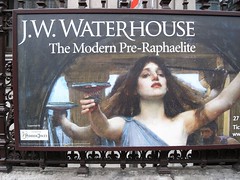J W Waterhouse: The Modern Pre-Raphaelite. What's that all about? For a start he wasn't a member of the PRB, in fact when William Holman Hunt, John Everett Millais and Dante Gabriel Rossetti founded the Brotherhood in 1848, John William had yet to be born. Ok, his models look decidedly Burne-Jones, but Ned wasn't stricty a Pre-Raph either, merely a follower - albeit Rossetti's pupil. And by the end of Waterhouse's working life, with Impressionism and Modernism all the rage, his paintings were considered old-hat. The slightly misleading subtitle has been picked from an 1895 quote by critic Harry Quilter who said Mr Waterhouse 'shows one of the most brilliant and essentially modern performances of this eclectic age ... [He] has chosen a pre-Raphaelite subject [St Cecilia], and yet has treated it in a way that is not pre-Raphaelite any more than it is impressionist'. In other words, he paints mainly mythological scenes a little more freely than his predecessors. And despite being a lifetime Academician, produced some of the most beautiful paintings in the world.
Anyone who was a student in the 1960s would almost certainly have had a Waterhouse poster on their bedsit wall next to a Beardsley (I had and probably still have 'Hylas and the Nymphs') - there was something about the Waterhouse chicks with their long straight hair, pubescent breasts and distant gazes - plus their association with singing and flowers - that struck a chord with hippy culture. 'The Lady of Shalott' remains a Tate Gallery bestseller.
His earlier works are more reminiscent of Alma-Tadema - hard edged and cold, like blown-up illustrations from an old history book, and lacking Alma-Tadema's style and colour sense. It's only when he started painting (half-naked) women, such as 'Consulting the Oracle' in 1884 and 'St Eulalia' in 1885 that he found his winning formula. After that it was hit after hit with different versions of the Lady of Shallott and Ophelia stories, lots of water, half-seen breasts and plenty of mythic femmes fatales en plein air . From books like The Pre-Raphaelite Sisterhood and Desperate Romantics, we know lots about the earlier Pre-Raph models, but little about Waterhouse's. Did he use the same model over and over, or like Burne-Jones could only draw women one way?
The exhibition at the Royal Academy was in its last week when I visited, and I had to queue for half an hour. I could have ordered my tickets over the internet, but that would have incurred a nasty booking fee! There were a lot more paintings than I'd expected, plus sketchbooks and drawn-in books of Romantic poems on display. Over the years I've been to solo shows of all the Victorian artists I admire - Holman Hunt last January in Manchester, Rossetti in Liverpool a few years back, plus Millais, Lord Leighton and Alma-Tadema in London - and feel this completes a set. Who else is there left to explore?
As far as I know, he wasn't related to either Alfred Waterhouse, the architect of Manchester Town Hall, or Keith Waterhouse, the writer of Billy Liar.
After the show, I popped down to Trafalgar Square to catch a Fourth Plinther - it was Emily P projecting 212 ping-pong balls into the audience to publicise Activinstinct. I caught a green one, but gave it to her friend - you may be able to spot me in the video.
some scribbles
6 years ago

1 comment:
Another sign of Waterhouse's enduring popularity is that the paperback of his catalogue was sold out 'due to unprecedented demand'.
Post a Comment